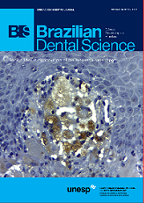Sequelae in primary teeth after traumatic injury
DOI:
https://doi.org/10.14295/bds.2017.v20i2.1350Abstract
Purpose: Determine the prevalence of injuries due to dislocation in the primary dentition and the associated sequelae in children treated at Pediatric Dentistry Clinic of the School of Pharmacy, Dentistry and Nursing, Federal University of Ceará. Material and Methods: The research protocol was reviewed and approved by the Institutional Research Ethics Committee Medical School of the Federal University of Ceará, Fortaleza, Ceará, Brazil. It was conducted through a transversal retrospective observational investigation. Data were collected from the medical records from 2000 to 2014. We use the statistical analysis software SPSS (Statistical Packacge for the Social Sciences) 17.0 for Windows. Results: The sample consisted of 52 patients, totaling 75 traumatized primary teeth. The average age at injury was 37.6 months and the most affected gender was male (65.4 %). Most injuries occurred at home (57.7 %) and consequently to fall from height (73%). The most common type of dislocation for injury was intrusion (53.3 %) and color change (42.7%), pulp necrosis (37.3 %) and obliteration of the root canal (13.3%) the most frequent sequelae. Conclusions: The high prevalence of sequelae (74.7 %) shows that proper treatment should happen at right time in order to reduce the occurrence of sequelae.KEYWORDS
Deciduous teeth; Sequelae; Tooth injuries.
Downloads
Downloads
Additional Files
Published
How to Cite
Issue
Section
License
Brazilian Dental Science uses the Creative Commons (CC-BY 4.0) license, thus preserving the integrity of articles in an open access environment. The journal allows the author to retain publishing rights without restrictions.
=================




























